Potrebujeme váš súhlas na využitie jednotlivých dát, aby sa vám okrem iného mohli ukazovať informácie týkajúce sa vašich záujmov. Súhlas udelíte kliknutím na tlačidlo „OK“.
ASTM D4436-13e1
Standard Test Method for Rock Bolt Long-Term Load Retention Test (Withdrawn 2022) (Includes all amendments And changes 1/14/2022).
Automaticky preložený názov:
Štandardná skúšobná metóda pre rock Bolt Long-Term Load retenčný test
NORMA vydaná dňa 1.11.2013
Informácie o norme:
Označenie normy: ASTM D4436-13e1
Poznámka: NEPLATNÁ
Dátum vydania normy: 1.11.2013
Kód tovaru: NS-27204
Počet strán: 5
Približná hmotnosť: 15 g (0.03 libier)
Krajina: Americká technická norma
Kategória: Technické normy ASTM
Kategórie - podobné normy:
Zemní práce. Hloubicí práce. Budování základů. Podzemní práce
Anotácia textu normy ASTM D4436-13e1 :
Keywords:
anchors (rock), field testing, loading tests, mines, pull testing, rock, ICS Number Code 93.020 (Earth works. Excavations. Foundation construction. Underground works)
Doplňujúce informácie
| Significance and Use | ||||||||
|
5.1 Rock bolts are used for support in a variety of mining and civil engineering situations.5.2 The local characteristics of the rock, such as roughness of the borehole and induced fractures, are significant factors in the load loss characteristics of the bolt. To obtain realistic values, the test holes should be drilled using the same methods as those used for the construction boreholes. 5.3 In establishing a testing program, the following factors should be considered: 5.3.1 Load retention tests should be conducted in all rock types where construction bolts will be installed. If the rock is anisotropic, for example, bedded or schistose, the tests should be conducted in the same orientations relative to the anisotropy as the construction bolts will be installed. 5.3.2 In each rock type, at each orientation, and for each anchor system, a sufficient number of tests should be conducted to determine the average and minimum long-term capacities within a fixed uncertainty band at the 95 % confidence level. The allowable uncertainty band depends on the project and involves such factors as rock quality, expected project lifetime, and importance of the areas to be bolted. The uncertainty band determination will require considerable engineering judgment. As a rough guideline, at least six long-term tests for a single set of variables have been found necessary to satisfy the statistical requirements. 5.3.3 The design load and installation load on the rock bolt system should be predetermined. The installation load is less than the anchor capacity, as determined by Method D4435. The design load is less than the installation load; the amount depends on rock properties and the minimum time required to encapsulate the bolts. Alternatively, this method can be run for a predetermined time interval based on construction requirements, and a realistic design load can be determined from the data. 1.1 The objective of this test
method is to determine the time over which rock bolt tension
decreases from the installed value to a designated minimum
value.
1.2 This test method is applicable to any anchor system which is not fully encapsulated immediately upon installation, including mechanical, cement grout, resin (epoxy, polyester, and the like) or other similar systems. 1.3 The values stated in inch-pound units are to be regarded as standard. The values given in parentheses are mathematical conversions to SI units that are provided for information only and are not considered standard. Reporting of test results in units other than inch-pounds shall not be regarded as nonconformance with this test method. 1.3.1 The gravitational system of inch-pound units is used when dealing with inch-pound units. In this system, the pound (lbf) represents a unit of force (weight), while the unit for mass is slugs. 1.4 All observed and calculated values shall conform to the guidelines for significant digits and rounding established in Practice D6026. 1.4.1 The procedures used to specify how data are collected/recorded or calculated, in this standard are regarded as the industry standard. In addition, they are representative of the significant digits that generally should be retained. The procedures used do not consider material variation, purpose for obtaining the data, special purpose studies, or any considerations for the user’s objectives; and it is common practice to increase or reduce significant digits of reported data to be commensurate with these considerations. It is beyond the scope of this standard to consider significant digits used in analytical methods for engineering design. 1.5 This standard does not purport to address all of the safety concerns, if any, associated with its use. It is the responsibility of the user of this standard to establish appropriate safety and health practices and determine the applicability of regulatory limitations prior to use. |
||||||||
| 2. Referenced Documents | ||||||||
|
Podobné normy:
Historická
1.2.2006
Historická
15.1.2010
Historická
1.10.2009
Historická
1.8.2012
Historická
1.6.2012
Historická
1.7.2008
Odporúčame:
Aktualizácia technických noriem
Chcete mať istotu, že používate len platné technické normy?
Ponúkame Vám riešenie, ktoré Vám zaistí mesačný prehľad o aktuálnosti noriem, ktoré používate.
Chcete vedieť viac informácií ? Pozrite sa na túto stránku.



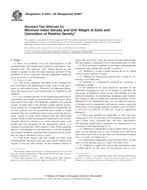 ASTM D4254-00(2006)e..
ASTM D4254-00(2006)e..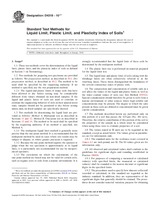 ASTM D4318-10e1
ASTM D4318-10e1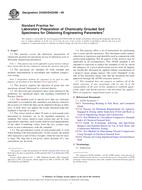 ASTM D4320/D4320M-09..
ASTM D4320/D4320M-09..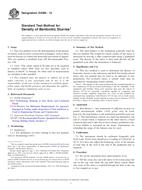 ASTM D4380-12
ASTM D4380-12 ASTM D4381/D4381M-12..
ASTM D4381/D4381M-12..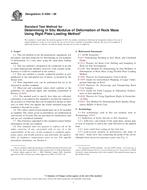 ASTM D4394-08
ASTM D4394-08
 Cookies
Cookies
